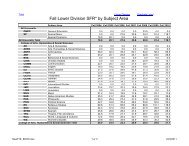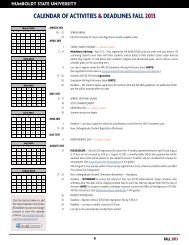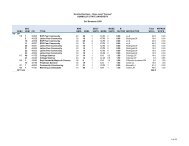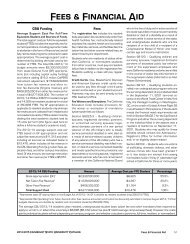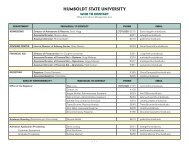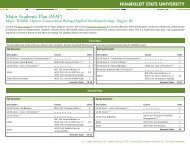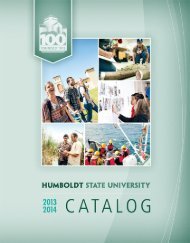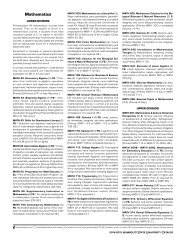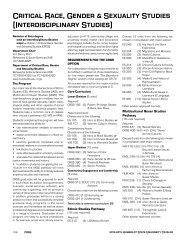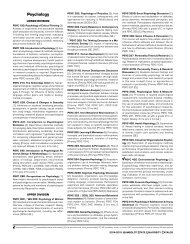2007-08 Academic Year - Humboldt State University
2007-08 Academic Year - Humboldt State University
2007-08 Academic Year - Humboldt State University
You also want an ePaper? Increase the reach of your titles
YUMPU automatically turns print PDFs into web optimized ePapers that Google loves.
NRPI 597 Mentoring & Teaching<br />
Associate Training or<br />
WLDF 597 Mentoring & Teaching<br />
Associate Training<br />
2) Higher Education Teaching Methods<br />
Guidance in the skills and knowledge relevant<br />
to teaching in higher education. Three units,<br />
taken first or second semester of the MS<br />
program:<br />
EDUC 583 Teaching in Higher Education<br />
Certificate requirements #3 & #4 come<br />
after completion of #1 (Discipline-Specific<br />
Teaching Methods) and after or concurrent<br />
with #2 (Higher Education Teaching<br />
Methods).<br />
3) Professional Development Seminar<br />
Explore the nature and philosophy of postsecondary<br />
institutions and their roles and<br />
functions in higher education. One unit,<br />
concurrent with the fourth requirement,<br />
which follows:<br />
SP 684 Orientation to Higher<br />
Education<br />
4) Mentored Teaching Internship Experience<br />
• Community College Track:<br />
Three units of a mentored teaching experience<br />
at College of the Redwoods.<br />
SP 683 College Faculty Preparation<br />
Internship<br />
(Note: Students successfully completing this<br />
course may apply in later semesters for a paid CR<br />
Faculty Internship if positions are available.)<br />
or<br />
• Pre-doctoral College Track:<br />
Three units of a mentored teaching experience<br />
at HSU.<br />
See Natural Resource Graduate Coordinator<br />
for advice on what course number to use.<br />
5) Capstone Experience<br />
Guidance in developing a professional<br />
teaching portfolio and job-search support<br />
materials. Two units, taken after all previous<br />
components have been completed.<br />
SP 685 Instructional Resources for<br />
Higher Education<br />
• • •<br />
Natural Resources Planning<br />
& Interpretation<br />
Bachelor of Science degree<br />
with a major in Natural Resources<br />
Planning & Interpretation—<br />
options in:<br />
Geographic Information Systems<br />
& Remote Sensing<br />
Interpretation<br />
Planning<br />
Recreation<br />
Individually Designed<br />
Minor in Geographic Information<br />
Technology<br />
Minor in Natural Resources (see<br />
Natural Resources)<br />
Minor in Natural Resources<br />
Interpretation<br />
Minor in Natural Resources Planning<br />
Minor in Natural Resources Recreation<br />
Certificates of study in<br />
Geographic Information Systems &<br />
Remote Sensing<br />
Natural Resources Interpretation<br />
Natural Resources Planning<br />
Natural Resources Policy &<br />
Administration<br />
Master of Science in Natural<br />
Resources—Natural Resources<br />
Planning & Interpretation option<br />
Department Chair<br />
Steven R. Martin, Ph.D.<br />
Environmental and Natural Resource<br />
Sciences Department<br />
Natural Resources Building 200<br />
(707) 826-4147, fax (707) 826-4145<br />
www.humboldt.edu/~enrs/<br />
The Program<br />
NRPI studies center on relationships between<br />
human society and natural ecosystems.<br />
Potential careers: environmental<br />
education leader, environmental impact<br />
analyst, environmental journalist, GIS or remote<br />
sensing analyst, hydrologist, information<br />
specialist, natural resource specialist,<br />
natural resources planner, naturalist, park<br />
ranger, recreation specialist, rural county<br />
planner, soil conservationist.<br />
GIS & Remote Sensing Option<br />
One of the fastest growing fields today is the<br />
use of geographic information systems (GIS)<br />
and remote sensing technologies to analyze<br />
the complex interrelationships between our<br />
natural resources and the human systems<br />
that depend on those resources. These<br />
computer-based technologies allow managers<br />
to evaluate large amounts of data over<br />
various sized geographic domains in order to<br />
be more effective in decision making.<br />
Public and private natural resource and<br />
land-use management agencies are rapidly<br />
incorporating these technologies, but they<br />
lack the understanding to use the systems<br />
correctly and fully. Students in this option will<br />
provide this important expertise. The strong<br />
natural resource background separates our<br />
program from similar programs in other<br />
universities. Students use the latest GIS and<br />
remote sensing software and hardware in<br />
the Spatial Analysis Lab and in other labs on<br />
campus. Internships and work experience<br />
are integral components.<br />
Already one of the highest demand employment<br />
areas, the market is projected to<br />
expand over the next decade. Graduates<br />
find careers with federal, state, and local<br />
public agencies; consulting firms; and natural<br />
resource-oriented private companies.<br />
Interpretation Option<br />
The philosophy of interpretation is captured<br />
by four elements: communication,<br />
inspiration, revelation, and experience.<br />
Interpretation as a science focuses on how<br />
to communicate artfully various histories,<br />
cultures, and environments to society. A primary<br />
goal is to inspire visitors’ understanding<br />
and appreciation, a necessary condition<br />
for promoting protection of a resource.<br />
Thematic interpretation reveals a whole<br />
<strong>2007</strong>-20<strong>08</strong> <strong>Humboldt</strong> <strong>State</strong> <strong>University</strong> Catalog<br />
Natural Resources Planning & Interpretation<br />
145



